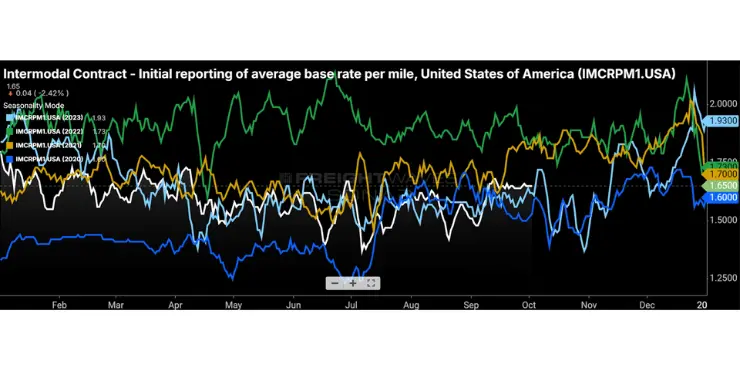The reefer and dry van freight markets are showing distinct differences in response to recent events, especially in the wake of hurricane relief efforts. As of now, the reefer tender rejection rate has spiked to an impressive 14%, signaling potential capacity tightening. In contrast, the dry van sector remains relatively stable at a 5% rejection rate. A notable portion of this increase in reefer rejections is outbound from Florida, highlighting the impact that emergency response efforts have on this segment. Although reefer tender rejection rates have been trending upwards for months, it’s clear that the recent hurricanes have intensified demand in the reefer market far more than in dry van. This trend may suggest a tighter supply and demand balance within the reefer sector.
On a recent third-quarter analyst call, J.B. Hunt’s management shed light on potential intermodal pricing shifts heading into 2025. Darren Field, the president of intermodal, expressed optimism about their positioning as the company starts its 2025 bid season. Highlighting J.B. Hunt’s strong service record and capacity to handle customer surges, Field indicated the company may be looking at favorable conditions for rate adjustments. A significant point of interest during the call was whether BNSF’s recent hire of Ed Harris, known for his precision scheduled railroading approach, could impact service levels. Hunt’s leadership remains confident that intermodal service standards will hold steady despite the shift.

On Monday’s episode of “The Stockout“, co-host Grace Sharkey and independent retail consultant Brittain Ladd discussed Amazon’s apparent plans to launch a large physical supercenter—a move seen as essential for competing in the grocery sector dominated by Walmart. Ladd, who broke the news on LinkedIn, praised the decision, viewing it as a strategic response to Walmart’s stronghold in grocery. While Amazon’s exact location for the supercenter remains under wraps, the development underscores Amazon’s ambition to rival Walmart on a broader scale.
In addition to Amazon’s plans, “The Stockout” episode touched on various retail insights, from Costco’s successful strategies to Whole Foods’ challenges in the market. A major topic was Kroger’s proposed acquisition of Albertsons. Ladd questioned Kroger’s claims that the merger would bring down prices, voicing skepticism about whether C&S Wholesale Grocers, who may acquire some divested locations, could truly compete against the larger combined entity. Although Ladd noted some issues with Kroger’s arguments, he believes there’s a 50/50 chance that the merger will pass regulatory scrutiny.
In an article by “The Wall Street Journal” over the weekend, insights into toy maker Mattel’s evolving supply chain strategy were shared. Mattel has been under pressure from activist investors to explore strategic changes to certain well-known product lines. Interestingly, many of Mattel’s strategies mirror those seen in consumer packaged goods (CPG) companies, especially in terms of reducing the number of SKUs—a 45% cut since 2018—to improve efficiency and streamline operations. Focusing on fewer, higher-velocity items allows Mattel to simplify inventory and extend production runs, much like CPG companies did during the pandemic when demand patterns were uncertain.
Reducing SKUs has quick operational benefits, including better inventory management and longer production runs with fewer interruptions. Mattel has also begun outsourcing production to meet fluctuating demand flexibly, which aligns with tactics employed by CPG companies during the pandemic. This strategy seems effective so far, as the company has posted gains in gross margins even without sales growth. However, cutting down on product variety does come with risks. Fewer SKUs may lead to the loss of potential breakout products that could unexpectedly become popular, an aspect that even advanced forecasting can sometimes miss.